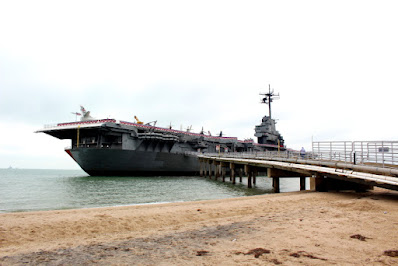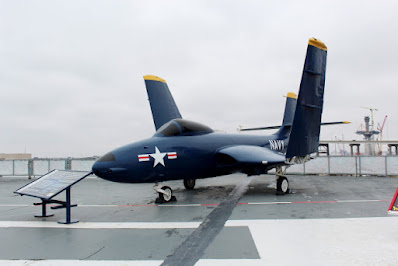The USS Lexington aircraft carrier is now open to the public as a floating museum in Corpus Christi, Texas. On four different occasions during WW II, the Japanese reported that they had sunk the Lexington. However, after each report, the carrier kept reappearing a few days later; so propogandist Tokyo Rose nicknamed the Lexington "The Blue Ghost." Unlike other ships that were painted with camouflage patters, the Lexington was never camouflaged and when seen at sea it appeared to be blue in color.
Gerald Ford, before he was president, served on the carrier. And, the Lexington was the first aircraft carrier in US Naval history to have a woman stationed aboard as a crew member.
In 1991 the Lexington was decommissioned and donated to Corpus Christi as a museum ship. She is now the oldest remaining fleet carrier in the world.
Visitors to the ship enter on the Hanger Deck level where there are a number of vintage aircraft, exhibits featuring aircraft engines, flight simulators, USS South Dakota model, café, and of course, a gift shop.
The USS South Dakota was one of the most famous battleships in WW II and saw extensive action around the world. A large scale model of the ship is on display, along with photographs of the ship being bombarded by the Japanese.
The USS South Dakota was the first of four South Dakota-class battleships built with 16-inch guns and increased armament. During the Second Naval Battle of Guadalcanal, the Japanese targeted the South Dakota and the ship sustained over two-dozen direct hits that significantly damaged the ship's superstructure. But, the ship did not sink. The South Dakota returned to the United States for repairs and then redeployed to support the British Home Fleet before moving on to the Pacific. Once back in the Pacific, the ship was part of the Gilbert and Marshall Islands Campaign, the Mariana and Palau Islands Campaign, the Philippines Campaign, Battles of Iwo Jima and Okinawa, and it bombarded Japan three times before the end of the war. After WW II, the ship was sent to the Philadelphia Naval Shipyard until 1962, when it was sold for scrap.
 |
| Japanese torpedo bomber attacking the South Dakota |
I was surprised to find out that there were escalators and elevators on the Lexington. On the lower decks are the galley, health facilities, chapel, library, combat information center, crew quarters, engine room, and historic exhibits.
The Flight deck and Bridge are some of most interesting places to visit. On the bridge it is possible to sit in the Capitan's chair and watch aircraft being launched. (Well, not actually, but it looks like a plane is being launched.) There is a Japanese flag painted on the back side of the tower above the guns where a Kamikaze plane hit the ship during an attack.
Located on the flight deck are a number of naval aircraft, most of which were manufactured after the Lexington was taken out of service.
At the end of the tour you run into something that you do not want to run into when on a ship.





































No comments:
Post a Comment